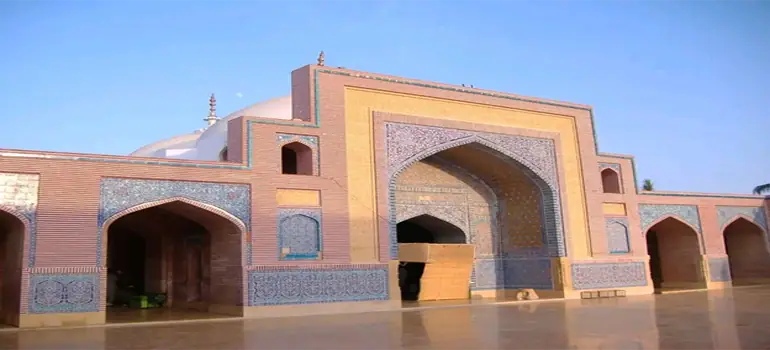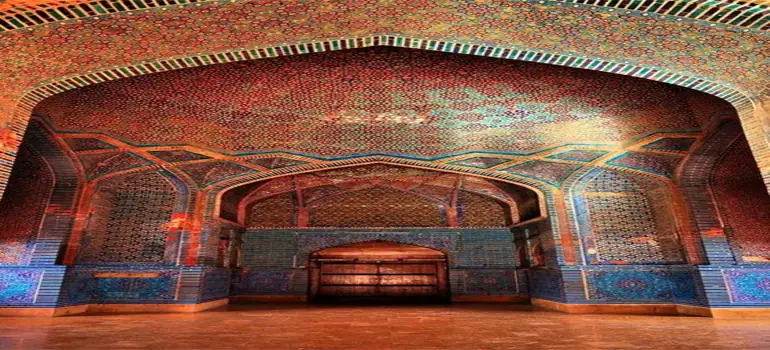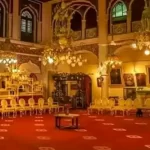
Shah Jahan Mosque
See the Shah Jahan Mosque, an outstanding representation of Mughal architecture, in Thatta, Pakistan (30 words). In this article, learn about its cultural relevance, preservation activities, and religious significance.
Shah Jahan Mosque in Thatta
An architectural wonder and a homage to the brilliance of the Mughal Empire, the Shah Jahan Mosque is located in the old town of Thatta, Sindh, Pakistan. This historic mosque, built in the 17th century under the reign of the legendary Mughal Emperor Shah Jahan, has enchanted tourists and residents with its ornate construction and skillful tile work. This article examines the Shah Jahan Mosque’s extensive history, unique parts of architecture, historical significance, and timeless appeal.
Location:
You may find the Shah Jahan Mosque in Pakistan’s historical city of Thatta, Sindh. Thatta is incredibly significant historically since it was once the capital of Sindh in the 14th century and a flourishing center of trade and culture. The city’s prosperous and culturally diverse past can be attributed to its ideal location along the Indus River.
The Shah Jahan Mosque is one of the buildings with historical significance in Thatta that has been kept well enough to be named a UNESCO World Heritage Site. Link: Shah Jahan Mosque – UNESCO Tentative List. The mosque is the main draw for visitors and history buffs visiting this historic city to see its architectural wonders.
- Advertisement -
Context of History:
Under the financial backing of Emperor Shah Jahan, work on the Shah Jahan Mosque finished between 1644 and 1647. This mosque in Thatta is a monument to the splendor of the Mughal Empire, which was known for its appreciation of art and architecture and left a lasting mark on the Indian subcontinent. Thatta, an ancient city in Sindh, had a significant function as a commercial and cultural center during the Mughal era. Shah Jahan picked this significant site to build a mosque that would be a place of worship and make a long-lasting mark on South Asian architecture.
Architectural Brilliance
The architectural grandeur of the Shah Jahan Mosque is readily apparent. Mughal, Persian, and Central Asian influences form an attractive structure. The mosque’s color scheme adds to its beautiful appeal because it was mainly constructed with red bricks and decorated with blue glazed tiles. The mosque’s huge central prayer hall is the focal point of the building’s exterior architecture. The hall’s majestic dome rises tall and proud, symbolizing the cosmic link between man and the divine, surrounded by lesser domes and beautiful minarets.
The Main Worship Hall
The central prayer hall, a location of spiritual significance for the Muslim community, is located at the center of the Shah Jahan Mosque. The hall’s roomy interior can hold a sizable crowd of believers, encouraging cohesion and dedication among those present.
The mosque’s main prayer hall is topped with a dome that adds to its grandeur and is designed so that light can pass through the stained-glass windows to create a tranquil and respectful atmosphere. Every person who enters this sacred area feels a tremendous spiritual sense since it serves as a haven for prayer, meditation, and thought.
Local building:
The Shah Jahan Mosque’s surrounding architecture, which extends beyond the main prayer hall, demonstrates the mastery of Mughal design principles. Fewer domes and minarets encircle the primary structure in a symmetrical setup that perfectly conveys the architectural balance and harmony that define Mughal buildings. The mosque’s beautiful minarets served as traditional call-to-prayer towers and improved its look. These smoothly rising, thin towers add to the mosque’s overall aesthetic and give the structure a feeling of verticality.

Role in religion and society:
The Shah Jahan Mosque is a well-known prayer site and a focal point for the Muslim community in Thatta and the surrounding area. The five daily prayers the faithful say in the mosque’s main prayer hall help to strengthen their sense of community and commitment. Thatta, Pakistan:
The mosque’s calm environment and beautiful tilework foster a sense of peace and spiritual reflection. In addition to its religious importance, the Shah Jahan Mosque is crucial for social cohesiveness. It serves as a hub for the neighborhood, giving residents a space to congregate and welcome one another.
Protection Initiatives:
The Shah Jahan Mosque suffered difficulties from the natural world and human effects throughout the years, requiring dedicated preservation efforts. Due to its historical and cultural significance, the Pakistani government and international organizations have taken steps to preserve this architectural wonder. Holding activities combine restoration, conservation, and upkeep to safeguard the mosque’s original splendor. Experts and skilled artisans devote many hours restoring faded tile work, fixing damaged areas, and maintaining the building’s structural integrity.

Conclusion
The Shah Jahan Mosque is a magnificent example of Mughal craftsmanship, adding to Thatta, Pakistan’s cultural legacy. Its magnificent architecture and historical significance have captivated generations of worshippers and visitors. The local Muslim community gathers in the mosque for prayer and thought, which continues to be a haven for the soul. With preservation efforts, it will be preserved for present and future generations to admire and appreciate. The Shah Jahan Mosque is a cherished UNESCO World Heritage Site because it continues to evoke wonder and reverence to represent cultural identity and unification. kutton-waterfall
The Shah Jahan Mosque was built when?
The mosque was built between 1644 and 1647 under Shah Jahan, the Mughal emperor.
2. What kind of design does the mosque have?
Architectural elements from the Mughal, Persian, Central Asian, and Indian periods are combined in the Shah Jahan Mosque.
3. What is the mosque’s location in religion?
For the Muslim community, it is a prominent place of worship and promotes social solidarity through events.







